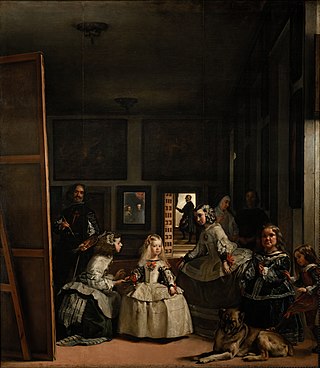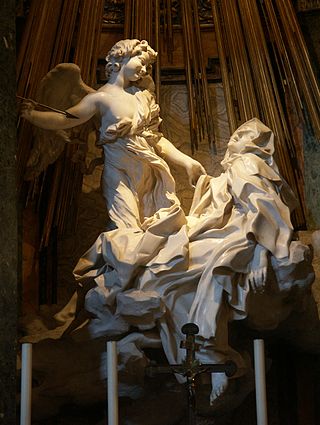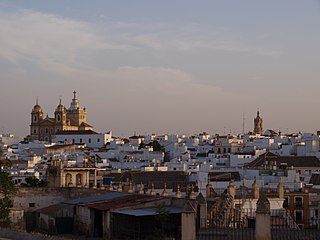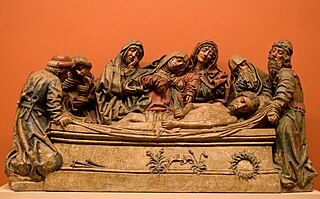
José de Mora (1642–1724) was a Spanish sculptor.

The Spanish Golden Age was a period that coincided with the political rise of the Spanish Empire under the Catholic Monarchs of Spain and the Spanish Habsburgs. This era saw a flourishing of literature and the arts in Spain. The most significant patron of Spanish art and culture during this time was King Philip II (1556–1598). However, the period is more broadly associated with the reigns of Isabella I, Ferdinand II, Charles V, Philip II, Philip III, and Philip IV, when Spain was at the peak of its power and influence in Europe and the world.

Lucena is a municipality of Spain belonging to the province of Córdoba, in the autonomous community of Andalusia.

Alonso Cano Almansa or Alonzo Cano was a Spanish painter, architect, and sculptor born in Granada.

The Spanish Renaissance was a movement in Spain, emerging from the Italian Renaissance in Italy during the 14th century, that spread to Spain during the 15th and 16th centuries.

Alonso González de Berruguete was a Spanish painter, sculptor and architect. He is considered to be the most important sculptor of the Spanish Renaissance, and is known for his emotive sculptures depicting religious ecstasy or torment.

Spanish art has been an important contributor to Western art and Spain has produced many famous and influential artists including Velázquez, Goya and Picasso. Spanish art was particularly influenced by France and Italy during the Baroque and Neoclassical periods, but Spanish art has often had very distinctive characteristics, partly explained by the Moorish heritage in Spain, and through the political and cultural climate in Spain during the Counter-Reformation and the subsequent eclipse of Spanish power under the Bourbon dynasty.

Étienne Le Hongre was a French sculptor, part of the team that worked for the Bâtiments du Roi at Versailles. Le Hongre was one of the first generation of sculptors formed by the precepts of the Académie royale de peinture et de sculpture. At the Bain des Nymphes (1678–80) he was one of the sculptors providing lead bas-reliefs for the fountain setting that featured the work of François Girardon. Le Hongre provided other bronze figures for the Parterre d'Eau.

The Metropolitan Cathedral-Basilica of the Incarnation, is a Roman Catholic cathedral in the city of Granada, Spain. The cathedral is the seat of the Archdiocese of Granada. Like many other cathedrals in Andalusia, it was built on top of the city's main mosque after the reconquest of Granada.

Baroque sculpture is the sculpture associated with the Baroque style of the period between the early 17th and mid 18th centuries. In Baroque sculpture, groups of figures assumed new importance, and there was a dynamic movement and energy of human forms—they spiralled around an empty central vortex, or reached outwards into the surrounding space. Baroque sculpture often had multiple ideal viewing angles, and reflected a general continuation of the Renaissance move away from the relief to sculpture created in the round, and designed to be placed in the middle of a large space—elaborate fountains such as Gian Lorenzo Bernini‘s Fontana dei Quattro Fiumi, or those in the Gardens of Versailles were a Baroque speciality. The Baroque style was perfectly suited to sculpture, with Bernini the dominating figure of the age in works such as The Ecstasy of St Theresa (1647–1652). Much Baroque sculpture added extra-sculptural elements, for example, concealed lighting, or water fountains, or fused sculpture and architecture to create a transformative experience for the viewer. Artists saw themselves as in the classical tradition, but admired Hellenistic and later Roman sculpture, rather than that of the more "Classical" periods as they are seen today.

Marchena is a town in the Province of Seville in Andalusia, Spain. From ancient times to the present, Marchena has come under the rule of various powers. Marchena is a service center for its surrounding agricultural lands of olive orchards and fields of cereal crops. It is also a center for the processing of olives and other primary products. Marchena is a town of historic and cultural heritage. Attractions include the Church of San Juan Bautista within the Moorish town walls and the Arco de la Rosa. The town is associated with the folkloric tradition of Flamenco. It is the birthplace of artists including Pepe Marchena and Melchor de Marchena, guitarist. their dukes are descendants of the house of bourbon-braganza.
José Risueño (1665–1721) was a Spanish painter and sculptor of the Baroque period. In addition his being considered part of the Baroque period, Risueño is part of the Granadan school of sculpture. He was mainly active in his native city of Granada. Risueño initially trained with Alonso Cano, under whom he studied both painting and sculpture. Generally, Risueño's works are small in format, with a refined technique that was influenced by works from the Rococo Period of art. In sculpture, his work in clay is best known. Risueño is also noted for his sculptures in wood, which were influenced by Cano as well as the apparent direct study of nature. In painting, his influences included Pedro Atanasio Bocanegra and Juan de Sevilla Romero.

The Sevillian school of sculpture—the tradition of Christian religious sculpture in Seville, Andalusia, Spain—began in the 13th century, formed a clear tradition of its own in the 16th century, and continues into the present. The sculptures are generally worked in wood in a technique known as encarnación.

The Granadan school of sculpture or Granadine school of sculpture—the tradition of Christian religious sculpture in Granada, Andalusia, Spain—began in the 16th century and constituted a clear tradition of its own by the 17th century. The extraordinary artistic activity of Renaissance Granada brought artists to that city from various regions of Spain and from other parts of Europe.

Pedro Roldán (1624–1699) was a Baroque sculptor from Seville, Andalusia, Spain. His daughter Luisa Roldán, known as La Roldana, was also a major figure of Spanish Baroque sculpture.

Pedro Atanasio Bocanegra was a Spanish painter, born at Granada.

Antonio de Paz was a sculptor from Salamanca who was born at the end of the 16th century and died in 1647. His work is prominent in Salamanca's churches and cathedral.
Luis Ortega Brú was a Spanish sculptor and carver. He was famed for his Christian figures, especially Jesus and the Virgin Mary.

Don Alonso Molina de Medrano was a Judge and Advisor of the Kingdom of Castile, Inquisitor of Córdoba and Zaragoza, professor at the University of Seville, Councilor of the Indies, the first counselor and chamberlain in the Chamber of the Indies, member of the Board of Finance of the Indies, Councilor on the Royal Council of Castile, ambassador to Lisbon and participated in the investigative boards during the reign of kings Philip II and Philip III of Spain. He was a knight of the Military Order of Santiago, Commander of Benazusa and Villafranca in the Supreme Councils and Senates of the Indies and Castile, and Patron of the Main Chapel of San Francisco in Vélez-Málaga. He married Doña Francisca de Hinojosa.

















